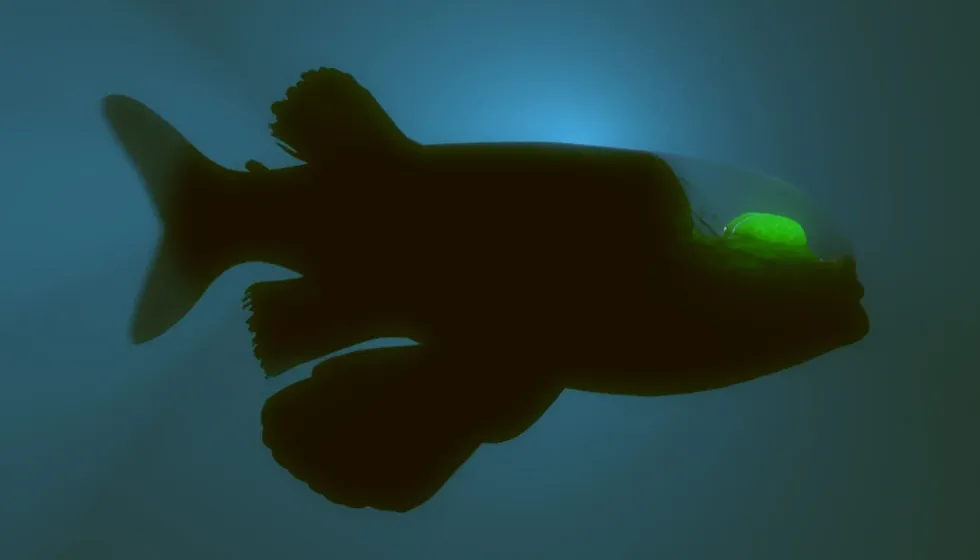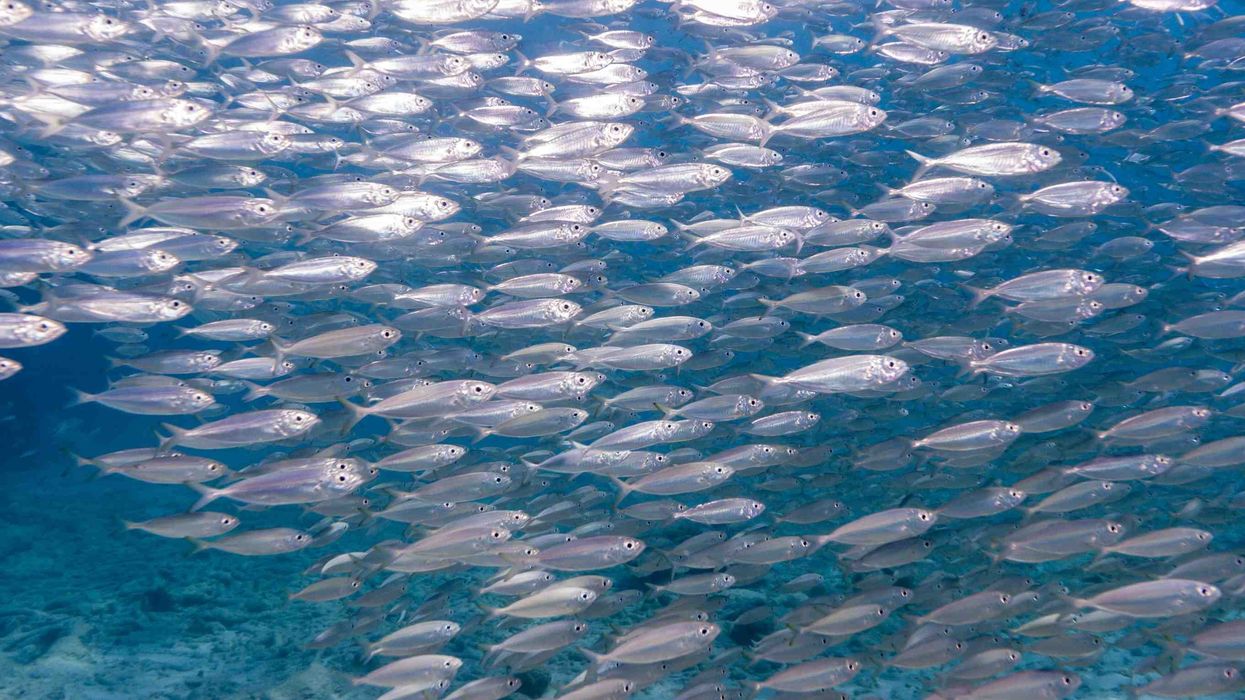The barreleye fish is a deep-sea spook fish that is named so because it has barrel-shaped eyes capped with lenses that are green. The eyes are not the only peculiar thing about this fish.
They are known for having a transparent head that fills with fluid and they are able to direct their eyes to see upward and forward.
They also have big, flat fins. This species was not very well known until the 2000s.
It is usually observed lying motionless with the help of its flat fins in deep-sea waters. While doing so, they turn their green-capped eyes upward to see their prey as well jellies, so that they can feed on the small animals hanging off their tentacles.
According to the Monterey Bay Aquarium Research Institute studies by marine biologists Kim Reisenbichler and Bruce Robison, their transparent heads and green pigmented eyes help in filtering out the sunlight reaching their deep-sea habitat.
They prefer the mild, temperate, deep-sea waters in the Pacific, Indian, and Atlantic oceans. More specifically, they have been observed in North Pacific marine waters, and off the coasts of places like Baja California, the Bering Sea and Japan.
For more relatable content, check out these facts about the longhorn cowfish and the bonito fish.
Barreleye Fish Interesting Facts
What type of animal is a barreleye fish?
The barreleye fish (Macropinna microstoma) is a deep-sea fish.
What class of animal does a barreleye fish belong to?
The barreleye fish (Macropinna microstoma) belongs to the Actinopterygii class of animals.
How many barreleye fish are there in the world?
The number of barreleye fish (Macropinna microstoma) in the deep waters of the world is unknown.
Where does a barreleye fish live?
The barreleye fish (Macropinna microstoma) is a deep-sea fish that lives in the ocean, mostly in the North Pacific Ocean, off the Californian coast. It also exists in the Indian and Atlantic oceans. Deep waters ranging from Baja California to the Bering Sea to Japan also have barreleye fish populations.
What is a barreleye fish's habitat?
Barreleye fish (Macropinna microstoma) prefer the temperate waters of the ocean. These animals exist at depths of 2,000-2,600 ft (600-800 m) in the Atlantic, Pacific, and Indian oceans. This fish lives in such a deep habitat because of its light-sensitive, green-capped, tubular eyes.
Who do barreleye fish live with?
Barreleye fish (Macropinna microstoma) usually live and hunt alone.
How long does a barreleye fish live?
The barreleye fish (Macropinna microstoma) wasn't a confirmed species until 2004, hence it is unclear how long this creature lives for as there is very little data about them available.
How do they reproduce?
Barreleye fish (Macropinna microstoma) reproduce by the external fertilization of eggs. Males and females of these creatures both release their sperm and eggs respectively in the water, which then fertilize and mature. The parents do not show any kind of care for the fertilized eggs or the young.
What is their conservation status?
The conservation status of the barreleye fish (Macropinna microstoma) has not been evaluated by the International Union for Conservation of Nature.
Barreleye Fish Fun Facts
What do barreleye fish look like?
Barreleye fish (Macropinna microstoma) typically grow to be up to 6 in (15 cm) long. These creatures have dome-shaped heads that are big and transparent.
This fish is an overall brown color. When looking at a barreleye fish, its transparent head allows you to see its light-sensitive, tubular eyes, as well as its other organs, nerve endings, and brain.
Barreleye fish have two holes in the front side that may look like eyes but are actually their olfactory organs for detecting smells, like human nostrils. The light-sensitive, tubular eyes have a green pigment that is for filtering the sun's rays.
This is so that they can spot the natural luminescence of their preferred prey, jellyfish. Another thing that has been noticed about them, thanks to their transparent head, is that the fish's tubular eyes are capable of looking upward and forward.
Most times, the eyes look upward to look out for the shadows of their prey. These creatures have big and flat fins that enable them to look motionless.

How cute are they?
Barreleye fish (Macropinna microstoma) can be considered to be a very cute animal. It is definitely one of the most unique creatures because it has a transparent dome-shaped head! You can literally see inside this transparent head.
It has two holes in the front of its face that look like eyes but are essentially a nose. Its actual tubular eyes can be seen through its head and it also has large fins that help it stay motionless.
These tubular eyes are capable of seeing both upwards and forwards. It is a small, brown, and adorable creature. Even barreleye fish toys are commonly sold as well!
How do they communicate?
The barreleye fish (Macropinna microstoma) species communicates with its surroundings via its tubular eyes and its olfactory sense. Their eyes are always looking upwards for prey, but they can also move to look forwards. They have two holes in the front of their face that are olfactory organs and they can lie motionless with the help of their fins.
How big is a barreleye fish?
Barreleye fish (Macropinna microstoma) grow to be up to 6 in (15 cm), which makes them two times smaller than Spanish mackerel fish, and about 20 times smaller than the giant guitarfish.
How fast can a barreleye fish swim?
It is unclear how fast barreleyes can swim since they have only been recently been confirmed and classified as a species.
How much does a barreleye fish weigh?
Not much data has been gathered on this, but because of their small size, they can be assumed to weigh around 2-5 oz (57-140 g).
What are the male and female names of the species?
Male and female barreleyes do not have specific names.
What would you call a baby barreleye fish?
A baby barreleye fish, just like any other fish juvenile, is called a 'fry'.
What do they eat?
Barreleye fish (Macropinna microstoma) feed on jellies, other siphonophores, and crustaceans. When they're young they also feed on zooplankton.
Are they dangerous?
No, barreleye fish are not dangerous to humans at all.
Would they make a good pet?
Barreleye fish are a relatively new species. They live deep in the sea and haven't been properly discovered yet, so there's no scope for them being taken as pets. Also, they're wild sea creatures, so they would not make good pets.
Did you know...
Anglerfish live at similar depths or even deeper than the barreleye fish.
The Monterey Bay Aquarium Research Institute is responsible for the studies unraveling the purpose and use of the transparent heads by the barreleye fish.
Barreleyes are synonymous with the family Opisthoproctidae, which consists of fishes with barrel-shaped eyes living at similar depths.
Barreleye fish are truly rare creatures. Because they exist at great depths, they haven't been observed properly and not much is known about them yet.
Barreleye fish may be endemic to the marine waters of the North Pacific ocean, off the coasts of places like Baja California to the Bering Sea to Japan.
Why does the barreleye fish have a transparent head?
The barreleye fish is a photosensitive creature. According to Monterey Bay Aquarium Research Institute studies by marine biologists, Kim Reisenbichler and Bruce Robison, this fish needs to filter out the sunlight that is reaching it.
The reason for this is so that it can see the jellies, which is its preferred prey, living above it. Barreleyes also have light-sensitive tubular eyes that mostly look upwards towards their potential prey and also aid in filtering out any sunlight, so their transparent head and fluid-filled shield at the top helps immensely.
What is unusual about the barreleye fish?
There are some really unusual things about the barreleye fish. The first is that it has a transparent head or a transparent shield that is fluid-filled.
The second is that it has light-sensitive, tubular, and 'barrel-shaped' eyes that mostly look upwards from the head towards its prey. However, as mentioned, barreleyes can also direct their eyes forward without maneuvering their head. How clever!
Their head and eyes are capable of filtering out the light from the sun. The third unusual thing is that this fish has two holes in the front of its head that look like eyes, but they are actually its olfactory senses, much like human nostrils.
Here at Kidadl, we have carefully created lots of interesting family-friendly animal facts for everyone to discover! Learn more about some other fish from our Atlantic mackerel facts or giant grouper fun facts for kids.
You can even occupy yourself at home by coloring in one of our free printable Barreleye Fish coloring pages.









